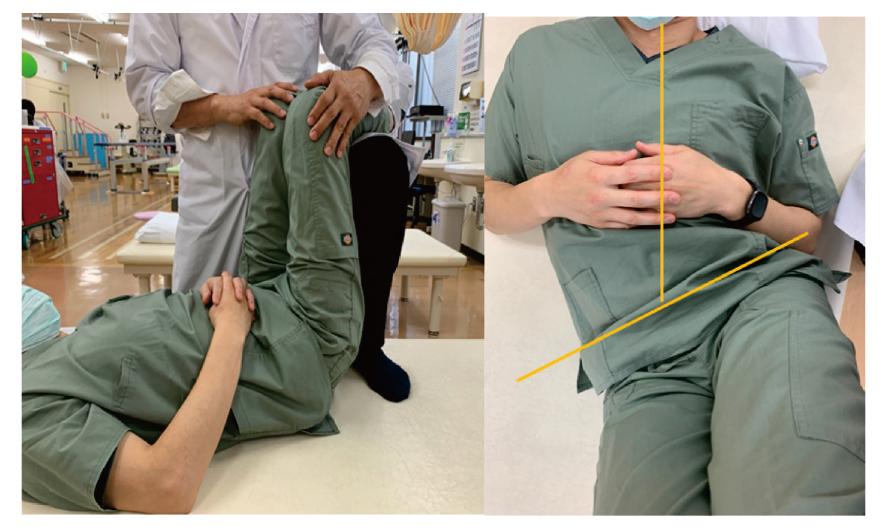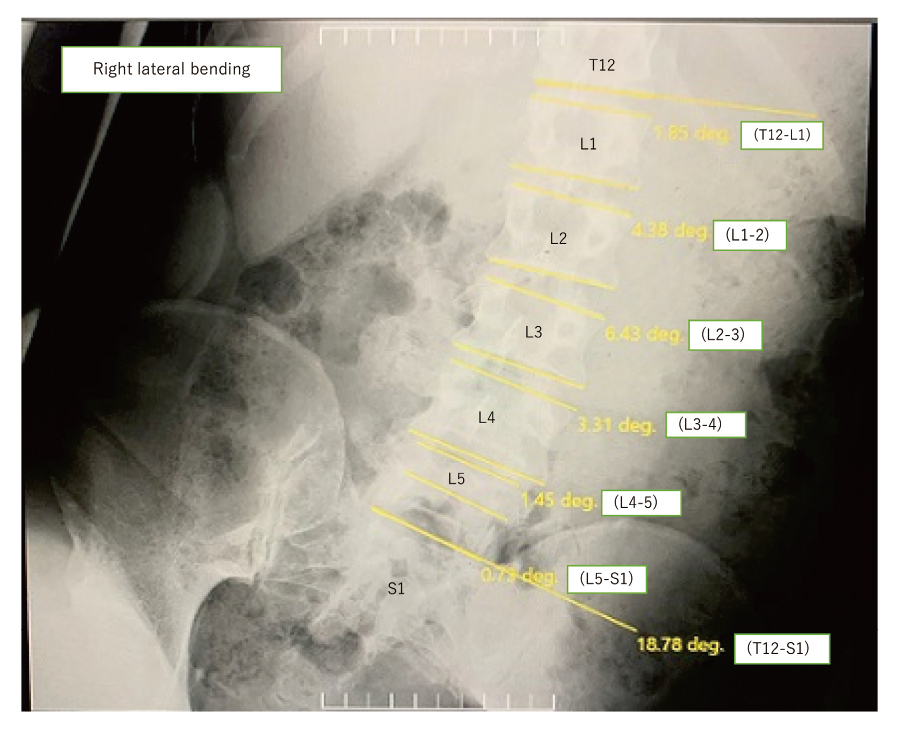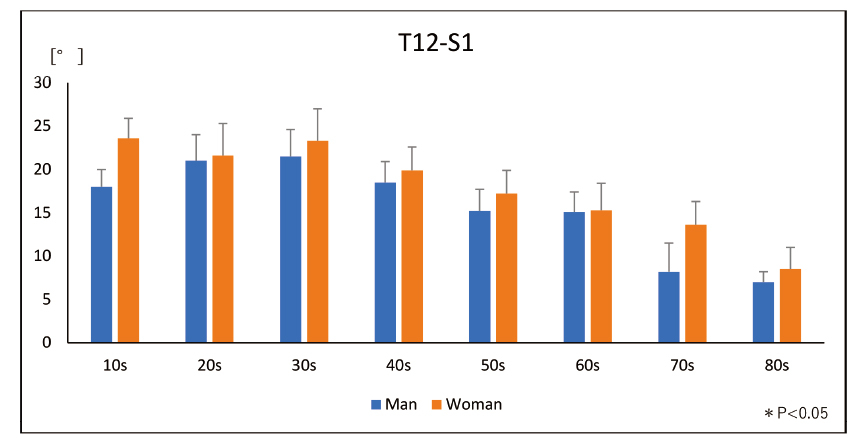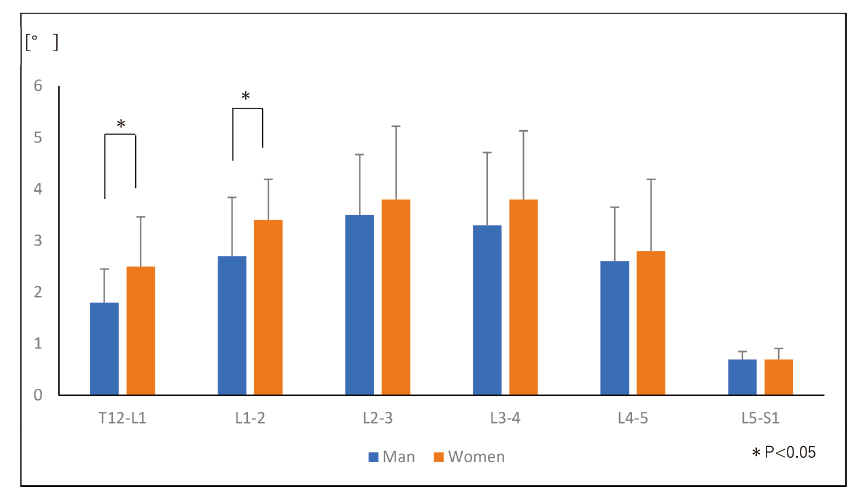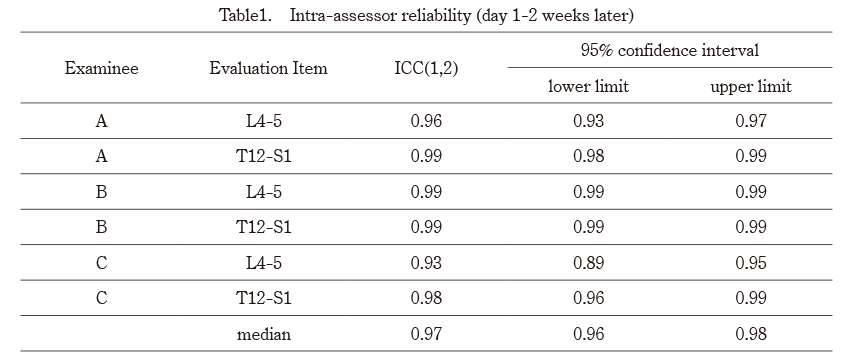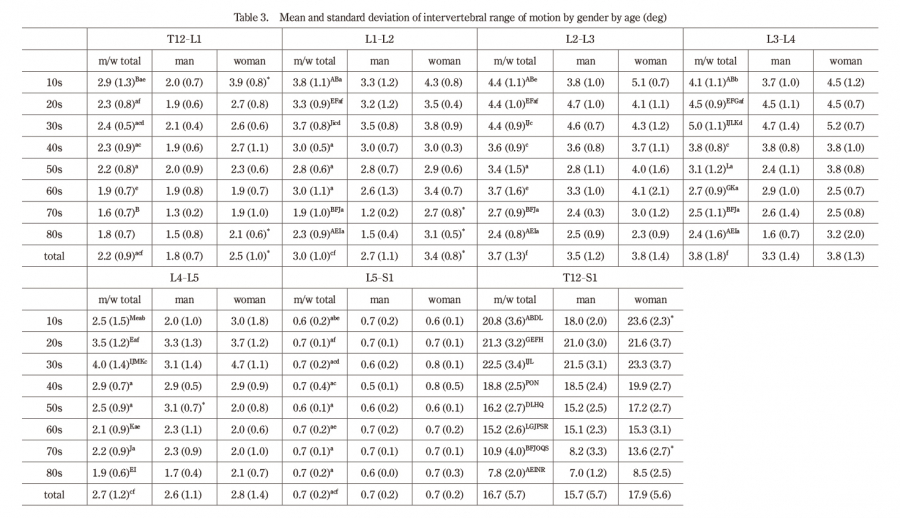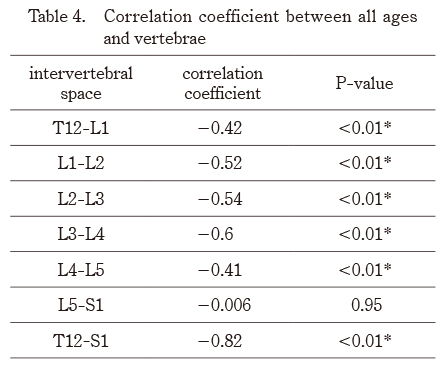[Purpose] The purpose of this study was to clarify the preliminary reference values for the lumbar spine range of motion associated with lateral bending exercises by gender and age group. [Methods] Subjects were 82 volunteers without low back pain, including five males and five females in each age group from 16-19 to 80-89 years. All subjects underwent radiographs of the lumbar spine with lateral flexion; the range of lateral flexion of the vertebrae from T12 to the sacrum (ROLB) was measured twice by three observers. [Results] The ROLB of the entire T12-S1 of all subjects showed a significant negative correlation with age in both sexes (p < 0.01). The ROLB of the lumbar spine tended to be greater in females, with a statistically significant difference between those aged 16-19 and 70-79 (p < 0.05). Lateral flexion angles for each intervertebral segment were largest at L3-L4 and smallest at L5-S1 (0.7°). [Conclusion] Lumbar ROLB reference values were examined by gender and age group; ROLB was greatest in L3-L4, and ROLB tended to be lower in older age groups.
Abstract/References
Reference values of lumbar spine range of motion by sex and age based on the assessment of supine trunk lateral bending-A preliminary study
Shigetaka Nakanishi, Kazuyuki Watanabe, Kazuo Ouchi, Michiyuki Hakozaki, Naoyuki Oi, Shinichi Konno
-
Shigetaka Nakanishi
Department of Rehabilitation Medicine, Fukushima Medical University School of Medicine
-
Kazuyuki Watanabe
Department of Orthopaedic Surgery, Fukushima Medical University School of Medicine
-
Kazuo Ouchi
Department of Rehabilitation Medicine, Fukushima Medical University School of Medicine
-
Michiyuki Hakozaki
Department of Orthopaedic Surgery, Fukushima Medical University School of Medicine
-
Naoyuki Oi
Department of Rehabilitation Medicine, Fukushima Medical University School of Medicine
-
Shinichi Konno
Department of Orthopaedic Surgery, Fukushima Medical University School of Medicine
Abstract
References
1. Household Statistics Office, Director-General for Statistics and Information Policy Director Toshiaki Hosoi, Deputy Director Chiharu Hashimoto, Yasuhiro Koike, et al. Summary Report of Comprehensive Survey of Living Conditions 2019. Ministry of Health, Labor and Welfare. 2020.
3. McCulloch JA. Focus issue on lumbar disc herniation:macro- and microdiscectomy. Spine (Phila Pa 1976), 21(24 Suppl):45S-56S, 1996.
6. Saruhashi Y, Mori K, Katsuura A, et al. Evaluation of standard nucleotomy for lumbar disc herniation using the Love method:results of follow-up studies after more than 10 years. Eur Spine J, 13(7):626-30, 2004.
7. Lumbar disc herniation guideline development group, Lumbar disc herniation guideline development committee. Lumbar disc herniation guideline. Nankoudo:57-58, 2005.
8. Tojima M, Ogata N, Yozu A, et al. Novel 3-dimensional motion analysis method for measuring the lumbar spine range of motion:repeatability and reliability compared with an electrogoniometer. Spine (Phila Pa 1976), 38(21):1327-1333, 2013.
9. Bible JE, Biswas D, Miller CP, et al. Normal functional range of motion of the lumbar spine during 15 activities of daily living. J Spinal Disord Tech, 23(2):106-112, 2010.
10. Huang RC, Tropiano P, Marnay T, et al. Range of motion and adjacent level degeneration after lumbar total disc replacement. Spine J, 6(3):242-247, 2006.
14. Ochia RS, Inoue N, Renner SM, et al. Three-Dimensional In Vivo Measurement of Lumbar Spine Segmental Motion. Spine (Phila Pa 1976), 31(18):2073-2078, 2006.
15. Hashemirad F, Hatef B, Jaberzadeh S, et al. Validity and reliability of skin markers for measurement of intersegmental mobility at L2-3 and L3-4 during lateral bending in healthy individuals:a fluoroscopy study. J Bodyw Mov Ther, 17(1):46-52, 2013.
16. Cook DJ, Yeager MS, Cheng BC. Range of motion of the intact lumbar segment:a multivariate study of 42 lumbar spines. Int J Spine Surg 5, 9:5, 2015.
Figures
